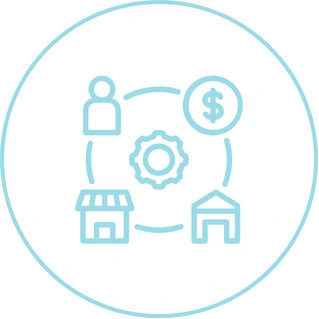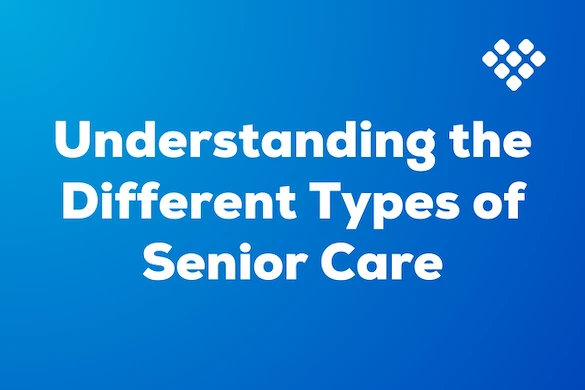
Understanding the Costs & How to Pay for Senior Living and Care
Navigate the complex world of senior living costs with our comprehensive, helpful guide.

Understanding the cost of senior living and care can be overwhelming. Whether you’ve been preparing for years or are in an unexpected situation, determining what you can and cannot afford is a difficult question to answer. It’s important to understand what options are out there, what can be covered under insurance or Medicare/Medicaid, and what costs you may incur in addition to your community monthly cost.
While it’s difficult to include everything, this guide aims to simplify the different cost components of senior living and care, average costs of senior living and care, hidden costs, financial assistance options and additional services you may need during this search like senior advisors, movers and their costs. We hope this guide can help seniors and their families have the transparent information they need to navigate this journey.
Key Takeaways




Cost Components of Senior Living and Care
The cost of senior living and care includes various components that contribute to the overall expense. Each component has its own set of factors that can affect the total cost, and understanding these elements can help in planning and budgeting effectively. Below is a list of some of the more common cost components.
-
Location: Costs vary significantly based on geographical location. Urban areas or regions with higher living costs generally have higher senior care costs. Use resources like our city pages to find care costs in specific locations near you.
-
Accommodation Costs: These include the type of living arrangement (private apartments, shared rooms, studio apartments), size, location within the community, and available amenities.
-
Meal Expenses: Most communities include meal costs in the overall fee, but the quality, variety, and any special dietary requirements can influence the total cost.
-
Healthcare Services: Basic healthcare services like regular check-ups and medication management are typically included, but specialized medical care can incur additional charges.
-
Activities and Amenities: These can include fitness programs, social events, beauty salon services, and transportation. Some services might not be included in the base fee and could lead to extra costs.
Average Costs of Care
Understanding the average costs for various types of senior care can provide a benchmark for what to expect financially. The following table outlines the average costs based on data from Genworth’s annual Cost of Care Survey unless otherwise noted. While these averages are helpful, it’s important to look at cost in your area to get an accurate picture of what each type of care might cost for you. Be sure to contact providers directly, or check out their website to see their up-to-date costs.
|
Type of Care |
Monthly Cost (National Average) |
|
Adult Day Health Adult day care is designed to relieve a caregiver of daytime duties while ensuring their loved ones receive proper care, typically hosted in a skilled nursing or assisted living community. |
$2,058 |
|
Assisted Living Assisted living is a type of residential community designed for people who need assistance with daily living activities, but still value their independence. |
$5,350 |
|
Home Care (Non-Medical) Non-medical home care, also sometimes referred to as companion care or private duty care, provides assistance with daily living activities in the comfort of your own home. |
$5,720 |
|
Home Care (Medicare-Certified) Medicare-certified home care provides a variety of medical and personal care services in the comfort of your own home. These providers are typically used after a hospital stay in leu of moving into a skilled nursing/long-term care community. |
$6,292 |
|
Hospice Hospice care is a specialized approach to end-of-life care that focuses on providing comfort, support, and dignity to individuals facing a terminal illness. |
$211.34 for the first 60 days and $167 for each additional day. (according to CMS) |
|
Independent Living Independent living are residential communities designed for adults aged 55 and older who do not require medical care or assistance but are interested in a maintenance-free lifestyle with social benefits. |
|
|
Memory Care Memory care communities are often found in assisted living communities but offer a designed safe, secure environment that caters to seniors with memory challenges. |
$6,160/month |
|
Skilled Nursing (Private Room) Long-term care/skilled nursing communities, often referred to as a "nursing home," provide around-the-clock medical care, encompassing both long-term care and short-term rehabilitation. |
$9,733 |
|
Skilled Nursing (Semi-Private Room) |
$8,669 |
Hidden Costs to Be Aware Of
Hidden costs can significantly impact the overall expense of senior living and care. Being aware of these potential extra charges can help you budget more accurately and avoid financial surprises. Below are some of the most common hidden costs of senior living and care. Be sure to ask providers about these costs when you tour or contact them to understand what is included in their monthly fee and an additional cost.
-
Entrance Fees: Some communities charge a one-time entrance fee – specifically CCRCs.
-
Medication Fees: Additional charges for medication management or prescription delivery.
-
Parking Fees: Costs associated with resident or visitor parking.
-
Pet Fees: Charges for keeping pets in the community.
-
Care Services: Fees for additional care services not included in the base package.
-
PT/OT Services: Costs for physical and occupational therapy services.
-
Beauty Salon Services: Extra charges for on-site beauty and grooming services.
-
Internet and Utilities: Fees for internet access and other utilities.
-
Transportation: Costs for transportation services provided by the community.


Hidden Costs to Be Aware Of
Hidden costs can significantly impact the overall expense of senior living and care. Being aware of these potential extra charges can help you budget more accurately and avoid financial surprises. Below are some of the most common hidden costs of senior living and care. Be sure to ask providers about these costs when you tour or contact them to understand what is included in their monthly fee and an additional cost.
-
Entrance Fees: Some communities charge a one-time entrance fee – specifically CCRCs.
-
Medication Fees: Additional charges for medication management or prescription delivery.
-
Parking Fees: Costs associated with resident or visitor parking.
-
Pet Fees: Charges for keeping pets in the community.
-
Care Services: Fees for additional care services not included in the base package.
-
PT/OT Services: Costs for physical and occupational therapy services.
-
Beauty Salon Services: Extra charges for on-site beauty and grooming services.
-
Internet and Utilities: Fees for internet access and other utilities.
-
Transportation: Costs for transportation services provided by the community.

Financial Assistance Options
Given the potential financial burden of senior living, exploring available financial assistance options is crucial. The Federal Reserve states that less than half of adults 60 and older have their savings on track. Given this landscape, many adult will need to rely on various programs and benefits to help offset some of the costs associated with senior care. Talk with an expert to help you understand what options you might qualify for.
-
Medicaid: Provides assistance for certain healthcare services based on eligibility.
-
Medicare: Covers short-term care costs, primarily for medical services, but not long-term living expenses.
-
Social Security: Benefits can be used to help cover the costs of senior living.
-
Veterans' Benefits: Veterans and their spouses may be eligible for benefits that help cover the cost of senior living.
-
Long-Term Care Insurance: Policies specifically designed to cover long-term care expenses can be beneficial.
-
Non-Profit Organizations: Some organizations offer grants or assistance for senior care.
-
Low-Income/Affordable Housing: Some communities are labeled as low income or affordable housing. These types of communities offer lower rent to eligible seniors. Eligibility is generally based on age and income. These types of housing providers are typically funded by the U.S. Department of Housing and Urban Development, the U.S. Department of Agriculture and the Low-Income Housing Tax Credit Program.
Paying for Senior Living and Care
Understanding what costs are covered by insurance, Medicare, Medicaid or will need to be covered by private pay can help manage expenses and ensure that you are utilizing all available resources.
-
Insurance: Long-term care insurance can cover a range of services from home health care to assisted living and skilled nursing care. Coverage specifics depend on the policy.
-
Medicare: Generally covers short-term care for rehabilitation, hospice, and certain home health services. It does not cover long-term care or custodial care.
-
Medicaid: Coverage varies by state but can include long-term care services both in nursing homes and in some community-based settings for eligible individuals.
-
Private Pay: Personal savings, home equity, pensions or other sources of income and assets.


Paying for Senior Living and Care
Understanding what costs are covered by insurance, Medicare, Medicaid or will need to be covered by private pay can help manage expenses and ensure that you are utilizing all available resources.
-
Insurance: Long-term care insurance can cover a range of services from home health care to assisted living and skilled nursing care. Coverage specifics depend on the policy.
-
Medicare: Generally covers short-term care for rehabilitation, hospice, and certain home health services. It does not cover long-term care or custodial care.
-
Medicaid: Coverage varies by state but can include long-term care services both in nursing homes and in some community-based settings for eligible individuals.
-
Private Pay: Personal savings, home equity, pensions or other sources of income and assets.

Additional Services and Their Costs
In addition to the core costs of senior living or care, there are various additional services that may be required during this transition. Understanding these services and their costs can help in planning and budgeting effectively. Below are some of the most commonly used services that families and their loved ones will use during their search for senior living and care.
-
Senior Advisors: Senior advisors (or senior helpers) can help navigate the complexities of finding and choosing the right senior living options. Their fees vary based on the level of service and consultation provided. Often the services are free for the family, the cost is passed to the community that the individual moves into (typically a month’s rent is the commissionable fee). Advisors can offer suggestions on type of communities, schedule tours, offer expertise and more!
-
Movers: Specialized senior moving services can assist with the physical move, downsizing, and organizing. Senior movers can also coordinate and conduct estate sales, offer advice on what to take with you and help with the physical move. Costs depend on the distance and the level of service required.
-
Estate Planning: Legal services for estate planning, including wills and trusts, are essential to ensure that the senior's assets are managed according to their wishes. Fees vary based on the complexity of the estate and the legal services required.
-
Medical Devices: When individuals choose to remain in a home and enroll in home care services, medical devices may be needed such as a hospital bed, handrails, wheelchairs, and more.
Conclusion
Understanding the full scope of senior living costs—including potential hidden fees and available financial assistance programs like Medicaid, Medicare, and veterans’ benefits—can make choosing the right community much less overwhelming. Being well-informed empowers seniors and their families to make confident decisions that align with their financial situation and care needs.
Need more help? Reach out to us and we will do our best to put you in contact with the appropriate party.


